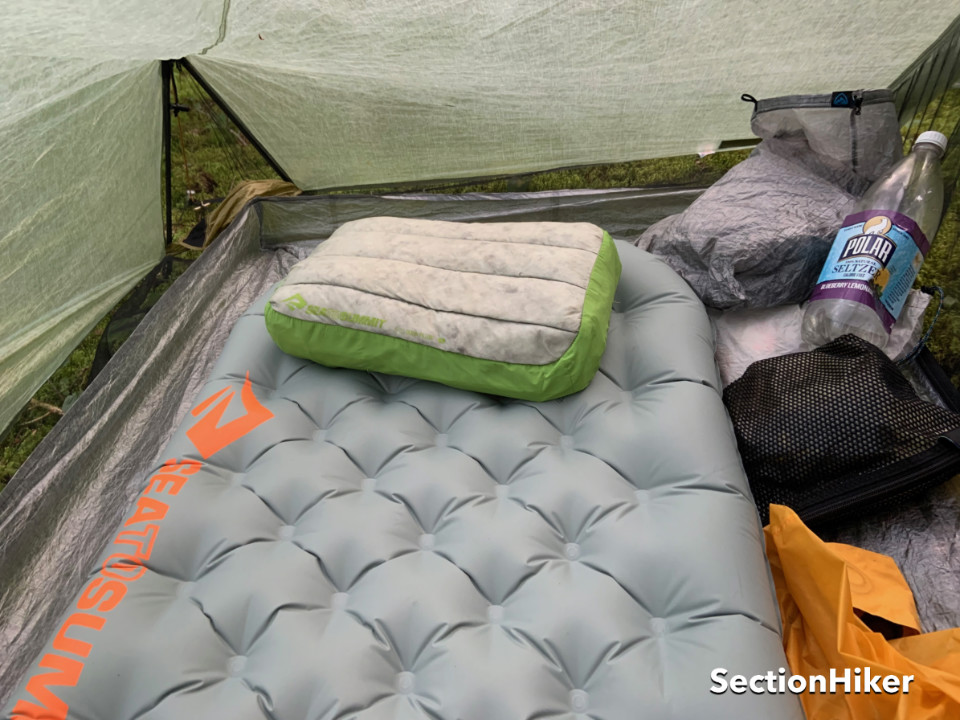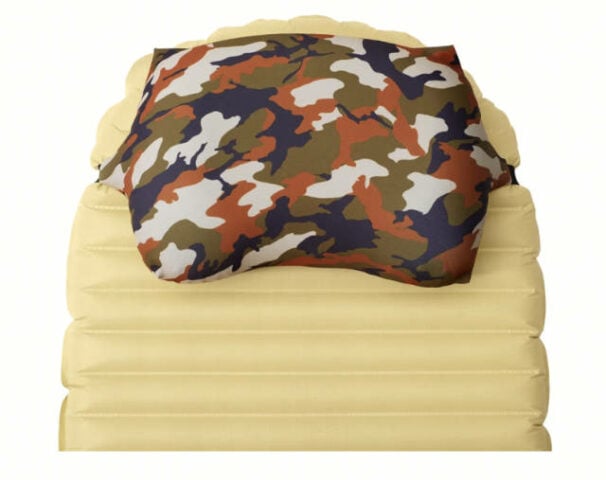
If you use a pillow at home, I recommend taking a camping pillow with you on your backpacking trips. You’ll almost certainly sleep better if you have one because your body is used to having the extra support. I learned this the hard way myself, trying all kinds of ways to reduce my backpacking gear weight by not carrying a pillow, only to discover that I sleep infinitely better when I bring one on my trips.
The most important thing to look for when buying a backpacking pillow is getting one that stays on top of your sleeping pad all night and doesn’t fall off. You’d think that backpacking and camping pillow manufacturers would have figured out this is a must-have attribute, but most don’t include any kind of pad attachment system to keep the pillow under your head all night.

Personally, I swear by the pillow attachment system that comes with Sea-to-Summit sleeping pads and works with Sea-to-Summit Camping Pillows. It includes special (and optional) non-abrasive hook-and-loop patches that adhere to your sleeping pad and stick to the underside of their pillows. I use this pillow attachment system with a 2.5 oz Sea-to-Summit Aeros Down Pillow and a Sea-to-Summit Insulated Etherlight XT Sleeping Pad and sleep like a baby on all my trips. Please note, this pad attachment system only comes with Sea-to-Summit sleeping pads and only works with their pillows.
When I started backpacking, I did not bring a dedicated pillow in order to reduce my gear weight. Instead, I stuffed an insulated jacket into a stuff sack and used that as a pillow, even though it didn’t provide the same support or head height that I preferred when sleeping at home. In hindsight, it was barely adequate and never stayed in place at night.
I tried numerous other pillows after that including the Flex Air Ultralight Pillow, the Hyperlight Mountain Gear Stuff Sack Pillow, the NEMO Fillo Pillow, etc., but none of them stayed in place either. As a result, I concluded that the pillow isn’t as important as the pillow attachment system.

Clearly what’s needed is a pillow attachment system that is sleeping pad and pillow independent. While I haven’t tried it yet, the new Pillow Strap pillow attachment system looks like it should fulfill that need nicely. Of course, you can probably achieve the same result by using a cutoff pair of pantyhose in a much less expensive way.
SectionHiker is reader-supported. We only make money if you purchase a product through our affiliate links. Help us continue to test and write unsponsored and independent gear reviews, beginner FAQs, and free hiking guides. SectionHiker.com Backpacking Gear Reviews and FAQs
SectionHiker.com Backpacking Gear Reviews and FAQs
I think we all go through many different pillow options. It’s a very relatable fight. I ultimately gave up on stuff sacks (too lumpy and compress too much) and air pillows (too bouncy) and ended up with an actual pillow, the Thermarest Compressible Pillow. It’s big and heavy, but almost like my pillow at home. It’s also affordable and will never deflate. Worth the weight and space it takes in my pack. No problems with it sliding off the pad either.
Agree!
I use the trekology aluft 2.0 inflatable pillow with detachable strap, with a buff stuffed with added clothing &/or my CCF sit pad. I’m a side sleeper, mostly, but I like a modular pillow height, depending on my needs.
I always found the inflatable pillows too flat – they never were thick enough to hold my head up properly – and I’m glad to see someone came up with a good way to hold it in place.
The two best pillows I’ve found are:
(1) my rain jacket, rain pants, and pack cover firmly compacted in a 10-15L stuff sack (or the smaller-than-most detachable lid compartment of my REI Flash pack.)
(2) a 2L MSR Dromlite (or Dromedary) filled with air – inflate by blowing into the little flip-up valve in the cap. It also works filled with water – though using water means the concerns about possible disasters don’t let me sleep deeply. (In the morning, I just put on my belt and suspenders and yawn my way down the trail.) You can adjust the water or air (or mixture of both) to dial in the necessary support.
I may have to experiment with some adhesive backed velcro to see if that might keep the pillow in place.
I was late to the game in terms of appreciating an inflatable pillow vice a dry bag with clothes stuffed inside at first. Eventually, I purchased a s2s inflatable pillow and tested it at home. It’s still there as my main pillow and I have bought a bunch more, including for gifts, as a result of the tryout — they are bloody effing comfy and well worth a few oz. An advantage of using a quality inflatable pillow is that you can adjust tension by adding or decreasing air to just the way you like it. My s2s pillows have both insulation and a microfleece exterior, thus, they are not only comfy but they clean up well with just a touch of Dr. Bronner’s liquid soap and then dry quickly. I do not like the hard plastic ring that is used to lock down a pillow to the air mattress. I control my pillow manually during sleep just fine, and I use both sides of a pillow especially if I am dirty and didn’t wash the pillow, and so I would benefit from an option to omit or be enabled to remove the locking rings, which I don’t want to carry. But just buy a quality inflatable pillow, you will never look back.
I bought the zpacks inflatable pillow which is superlight and compact. I used fabric glue to affix some velcro to pillow and pad and it works well.
My night time routine includes tucking my partially filled Trekology inflatable (covered with a toddler pillowcase) in the hood of my mummy bag so it doesn’t slip. Then I take another pillowcase, fill it with my clothes and use that as a pillow over my head – to keep out noise.
Big Sky International “Dreamsleeper” is nice and seems to stay I’m place for me I use a spare nick buff for a pillowcase. If you have one of those already it keeps the cost down.
Wiggys on many sleeping bag models will include a lamilite filled pillow. For the Wiggys bags I use, this pillow fits perfectly in the sleeping bag’s head space.
While this works for my sleeping bags, I suspect the same concept will work for other setups. This keeps the pillow inside the sleeping bag no matter what
you sleep on.
I use a t-shirt for years that goes over the pillow in combo with the pad.
Excellent idea!
I do that too, snap!
I often do, too–it works great. Although my wife asks why I’m carrying that extra (heavy in her opinion) t-shirt (she has one to hike in and one to sleep in). Yes, Kate–I may be carrying an extra five and a quarter ounces!
I have used a pillow for years after going through the same experience you did. It’s worth the weight, particularly as one gets older and more “fragile.” Inspired by the Sea to Summit system, which I have, I created my own for other pads with light adhesive velcro. Works great!
Years ago, I got a Therm-a-Rest dual function stuff sack with a fleece liner so it doubled as a pillow. Once the sleeping bag comes out, I reverse the stuff sack so the soft fleece is to the exterior, put my day clothes in, stuff it to the firmness of pillow I want, and use that inside of the hood of my mummy bag. System works well with only a minor increment of weight. I have not seen this for sale for many many years, however.
The first comment on the pillow strap link says to use a buff and two shock cords instead. You can stuff your pillow in there.
I like that because a lot of times I will tuck my arm under my pillow.
After many a night of chasing my pillow and trying to keep it under my head, I purchased a Pillow Strap. I was very pleased that the strap fits my 25 inch wide, 4 inch deep sleeping pad. My only disapointment was that my Klimat pillow sprung a leak. I am now waiting for the inflatable pillow sold by the Pillow Strap folks At $16 ($19 with shipping) it is far less expensive than other inflatable pillows of its size. At that price, I may oder a few extras so I can keep one in my carry on bag for air travel.
I have a sleeping problem when hiking in that as an older person (I’m 78) I suffer from acid reflux. At home, I have an electric bed so not a problem but when I’m in my tent I use a second pillow (a blow-up type) and place it under the head end of my Thermarest Neo Air mattress. I then have my head resting on my second pillow which is usually just enough to keep my acid in my stomach (my stomach valve doesn’t close properly) and not in my oesophagus. Its a nuisance but I’ve learned to live with it.
I use an inflatable S2S pillow and lock it down to my S2S pad with standard velcro strips–I bought the pillow prior to S2S coming up with their current locking system. Have done this for a couple of years with no observable harm to the pad or pillow. However still have trouble getting adequate sleep, I think for two reasons. First, even when partially inflated, my air pillow is hard, unyielding. Second, not enough loft (pillow is around 4″) for a side-sleeper. So I’ve finally given in and bought a padded Nemo pillow that is heavier and will take up more pack space, but will hopefully be somewhat softer and be more adjustable height-wise. We shall see.
I hadn’t thought of putting something UNDER the mattress to elevate it – that’s a great idea. Thanks!
I used to use a trekology pillow until the internal bladder burst. Now I use a compressible pillow inside the trekology case so have a burst proof pillow with a pad strap. It all lives in a compression sack.
I’ve got a thin rectangular stuff sack made of soft, smooth fabric that my Sea-to-Summit inflatable pillow just happens to fit perfectly inside. I’ve been finding that partially inflating that pillow (probably less than half full) and then adding anything in my pack that’s extra soft (fleece layers, down puffy) on top, inside the stuff sack, gives it that more pillow-like feeling that I need to sleep better. I haven’t completely solved the keep-pillow-on-pad issue with this set-up, but sometimes use a mosquito head-net to hold the pillow on the pad.
That’s a neat solution – headnet.
2x Nemo Fillo Elites for me. Sidesleeping exclusively. First one is filled 100%, and the one on top of that maybe 80%. It achieves the perfect horizontal spine alignment for me and finds me waking up feeling like I slept at home. I haven’t had to bother with a makeshift strap solution, but shock cord on the loops on the pillow and vale step would probably work fine.